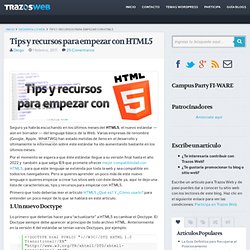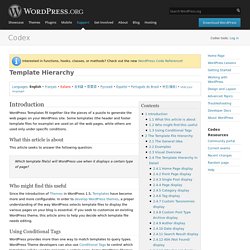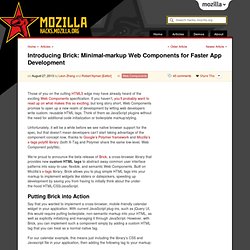HTML5
> Leonardomolina
> Development
Tips y recursos para empezar con HTML5. Seguro ya habrás escuchando en los últimos meses del HTML5, el nuevo estándar — aún en borrador — del lenguaje básico de la Web.

Varias empresas de renombre (Google, Apple, WHATWG) han estado metidas de lleno en el desarrollo y últimamente la información sobre este estándar ha ido aumentando bastante en los últimos meses. Por el momento se espera a que éste estándar llegue a su versión final hasta el año 2022 y también a que salga IE9 que promete ofrecer mejor compatibilidad con HTML5, para que este lenguaje se extienda por toda la web y sea compatible en todos los navegadores. Pero si quieres aprender un poco más de este nuevo lenguaje o quieres empezar a crear tus sitios web con éste desde ya, aquí te dejo una lista de características, tips y recursos para empezar con HTML5. Primero que todo deberías leer el artículo HTML5 ¿Qué es? Y ¿Cómo usarlo? 1. Lo primero que deberías hacer para “actualizarte” a HTML5 es cambiar el Doctype. 2. 3. 4. 5. Antes: Después: 6. 7. <header> y <footer> 8.
Template Hierarchy. Languages: English • Français • Italiano • 日本語 • 한국어 • Русский • Español • Português do Brasil • 中文(简体) • (Add your language) Introduction WordPress Templates fit together like the pieces of a puzzle to generate the web pages on your WordPress site.

Some templates (the header and footer template files for example) are used on all the web pages, while others are used only under specific conditions. What this article is about This article seeks to answer the following question: Which template file(s) will WordPress use when it displays a certain type of page? Who might find this useful Since the introduction of Themes in WordPress 1.5, Templates have become more and more configurable. Using Conditional Tags WordPress provides more than one way to match templates to query types.
The Template File Hierarchy The General Idea WordPress uses the Query String — information contained within each link on your website — to decide which template or set of templates will be used to display the page. Examples. Brick. Introducing Brick: Minimal-markup Web Components for Faster App Development. Those of you on the cutting HTML5 edge may have already heard of the exciting Web Components specification.

If you haven’t, you’ll probably want to read up on what makes this so exciting, but long story short, Web Components promise to open up a new realm of development by letting web developers write custom, reusable HTML tags. Think of them as JavaScript plugins without the need for additional code initialization or boilerplate markup/styling. Unfortunately, it will be a while before we see native browser support for the spec, but that doesn’t mean developers can’t start taking advantage of the component concept now, thanks to Google’s Polymer framework and Mozilla’s x-tags polyfill library (both X-Tag and Polymer share the same low-level, Web Component polyfills). We’re proud to announce the beta release of Brick, a cross-browser library that provides new custom HTML tags to abstract away common user interface patterns into easy-to-use, flexible, and semantic Web Components.
Create offline Web applications on mobile devices with HTML5. Introduction The use of Web development in mobile applications is an increasing trend.

However, intermittent network availability is a big obstacle to using Web technology as part of a cloud infrastructure. A traditional Web application simply doesn't work without a network. One solution to this problem is to use two features of the HTML5 Standard (see Resources): Offline Web applicationsClient-side database storage The user can use cloud functions on a mobile device, work offline with a locally deployed application on a local database, and share data with the rest of the cloud when going online again. In this article, learn the technical details for a typical usage scenario. Download the source code for the example application in this article from the Download table below. Overview Figure 1 shows an overview of the major components of the sample application architecture.
Figure 1. HTML page The HTML page, the core of the application, has the model role. JavaScript Cascading Style Sheet.




